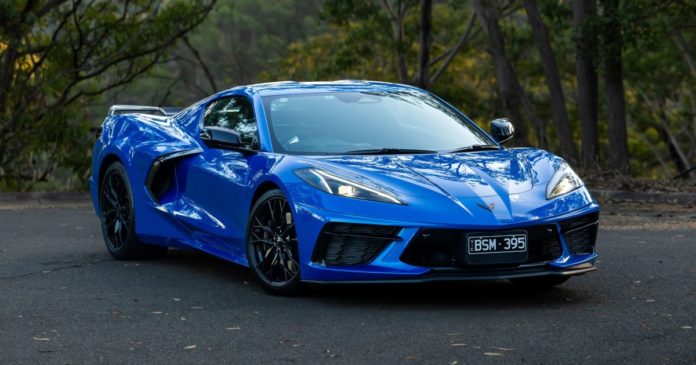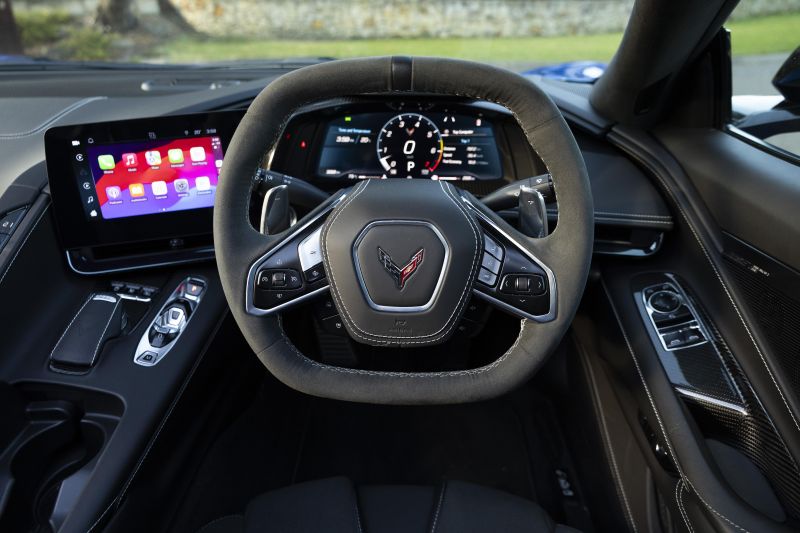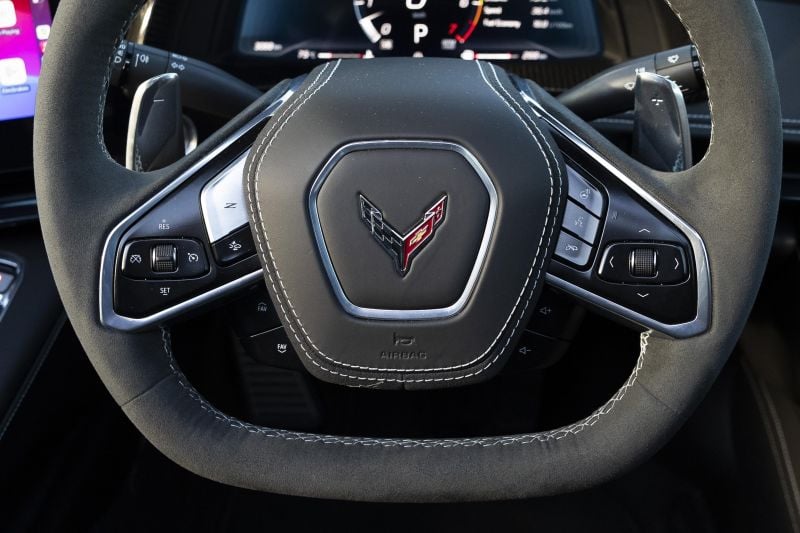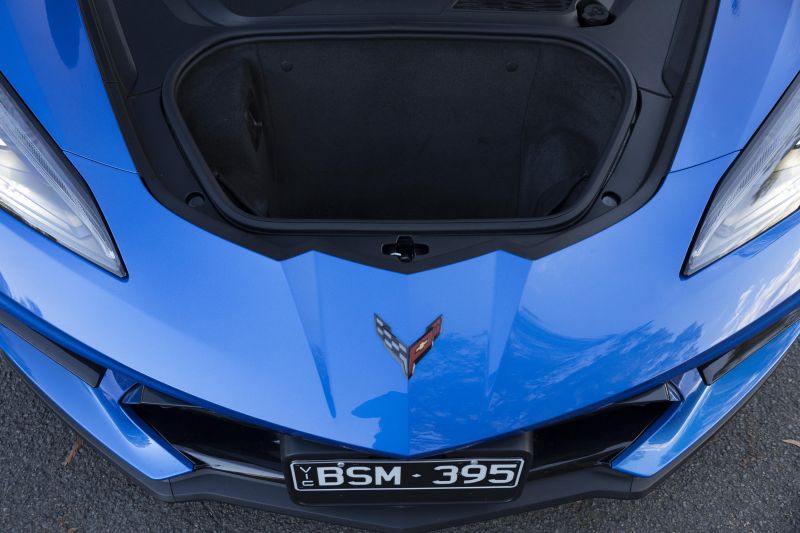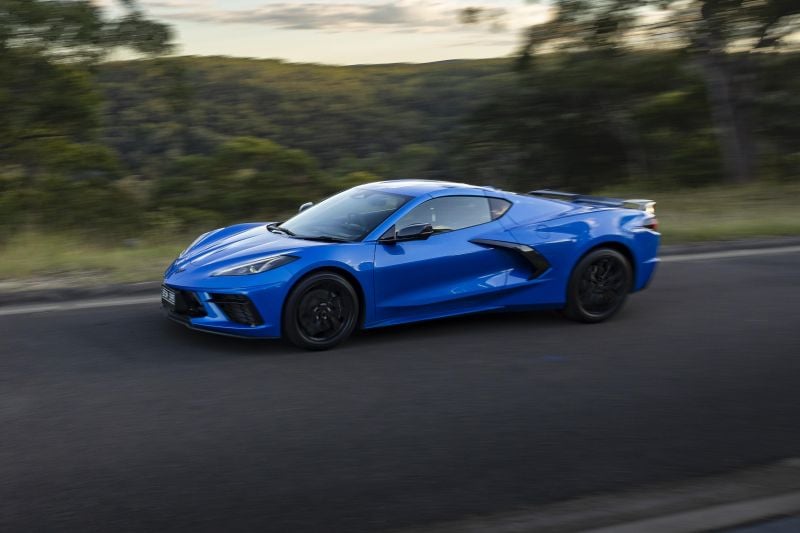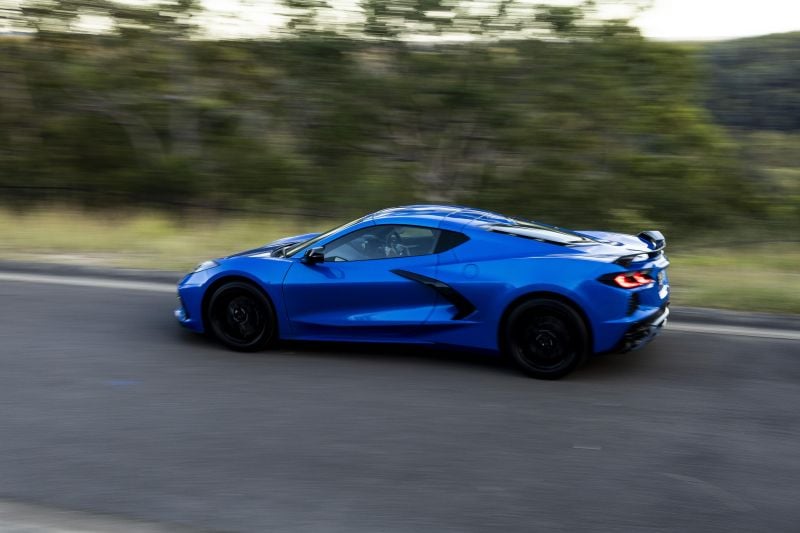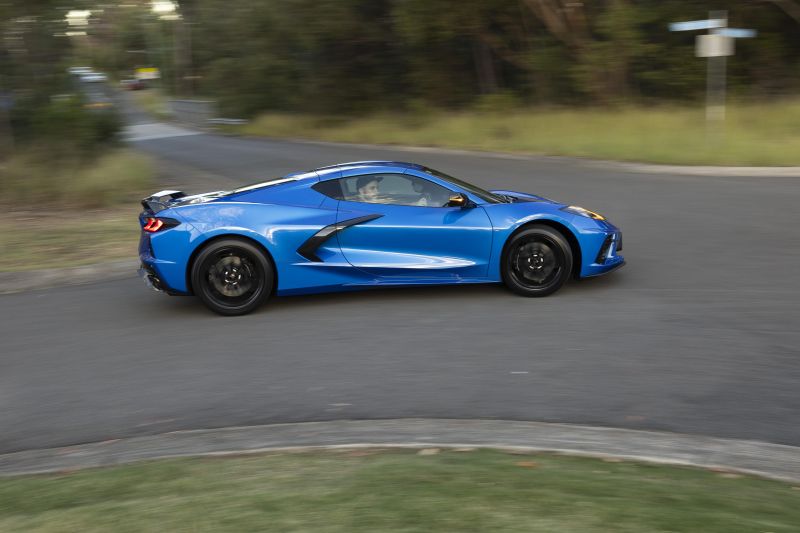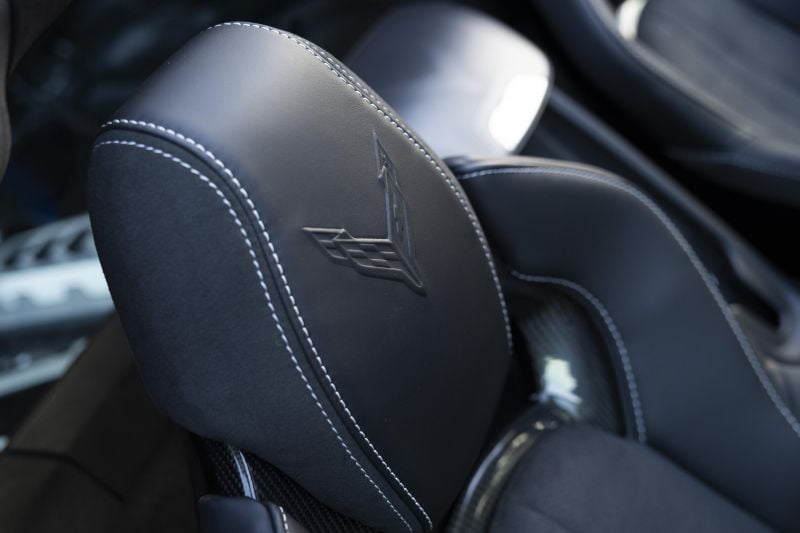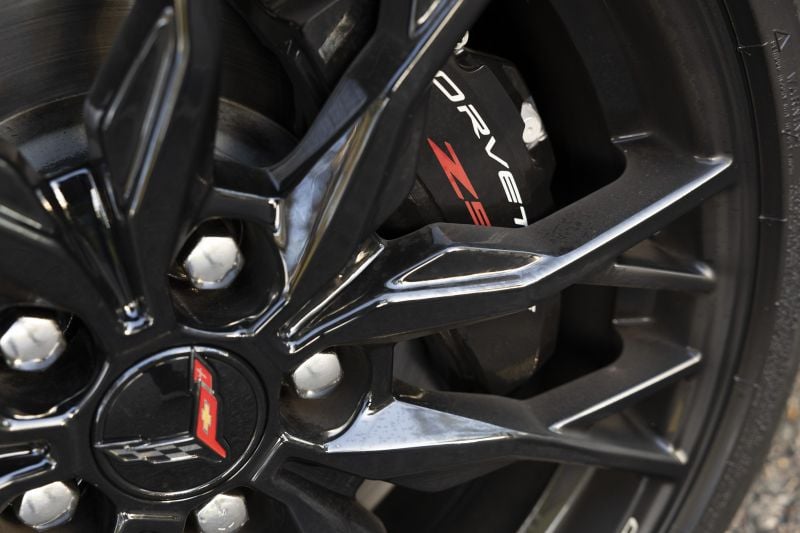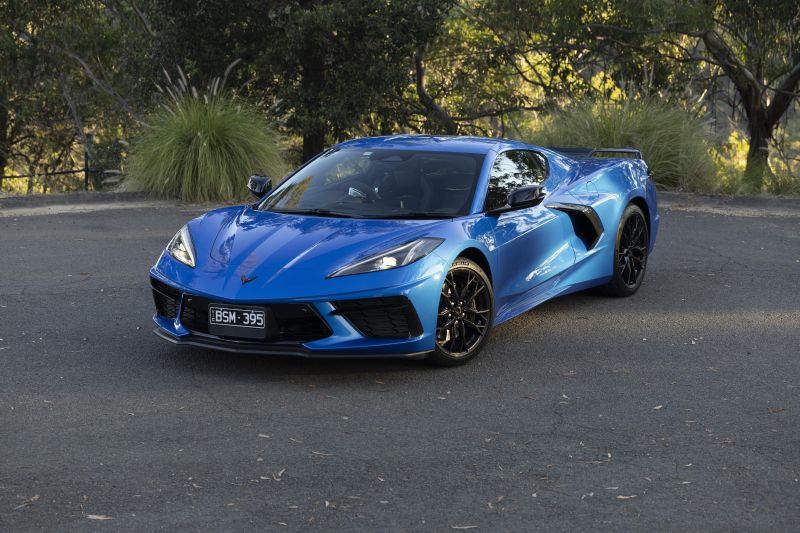The Chevrolet Corvette occupies a really interesting position in the Australian market.
This is the most affordable way into a V8-powered supercar, and in fact it costs less than half of what some of its well-known European rivals do.
And with a starting price of $175,000 plus on-roads, it’s hardly a cheapie – and indeed, it seems a bit pricey if you do a like-for-like against the model’s positioning in its home US market.
But honestly, it has the driving dynamics and a screaming V8 powertrain that make it stand out as something of a performance car bargain.
How does the Chevrolet Corvette compare?
View a detailed breakdown of the Chevrolet Corvette against similarly sized vehicles.
Chevrolet
Corvette
How much does the Chevrolet Corvette cost?
There are a few takes on the Corvette theme, and a new version – the E-Ray hybrid – is also on its way later in 2024. The version tested here is the 2024 Chevrolet Corvette 3LT Coupe, which is priced from $190,000 plus on-roads.
2024 Chevrolet Corvette pricing:
| Model Variant | $RRP |
|---|---|
| 2024 Chevrolet Corvette 2LT Coupe | $175,000 |
| 2024 Chevrolet Corvette 2LT Convertible | $190,000 |
| 2024 Chevrolet Corvette 3LT Coupe | $190,000 |
| 2024 Chevrolet Corvette 3LT Convertible | $205,000 |
| 2024 Chevrolet Corvette Z06 Coupe | $336,000 |
Prices exclude on-road costs
Now, I think it’s worth calling out a few of the optional extras fitted to this test vehicle, which push the price a fair bit higher.
These include 20-inch gloss black forged wheels ($3640); exterior black accent package for mirrors and spoiler ($325); high-gloss carbon-fibre interior trim ($3900); Stealth interior trim pack ($1560); and the Jet Black interior with Competition Seats, including interior trim and steering wheel with suede inserts ($11,050).
Yes, all told, it’s well over $210,000 before on-roads. But supercar rivals with V8 powertrains from Ferrari and Lamborghini are well over double the money – and it comes well equipped, too. More details below.
What is the Chevrolet Corvette like on the inside?
Is it as ‘wow’ as a Ferrari or Lambo inside? Arguably not, but it does have some special finishes and tech that make it very practical.
I love the way the cockpit is divided between the driver and passenger – indeed, it feels like ‘cockpit’ is the right word.
Along the ridge of the centre divider runs an array of buttons like nothing else in the market, and frankly I didn’t know how useable it would be in daily driving. But it’s so easy to get to terms with the controls for the dual-zone climate control, fan speed and seat heating and cooling that it becomes second nature in next to no time.
Passengers, however, may find it to be a little uncomfortable, as there’s not really any space for them to rest their arms, nor to reach over and adjust things on the media screen. Forget them – this car’s about the driver.
It’s all designed to make the pilot feel like they’re in their own control zone, and it works… for the most part.
The touchscreen media system looks teeny-weeny by modern standards, and it’s very basic. Honestly, I just connected my phone to wireless Apple CarPlay in case I needed to take or make calls, because otherwise I wasn’t planning to listen to anything other than the V8 engine mounted just behind the cabin.
While the drive modes have cute Playstation-like graphics for when you change between settings, it’s otherwise a pretty basic system.
Below the screen sits a rotary dial drive mode selector, and ahead of that are some of the most important buttons in the car – the nose-lift button (which will raise the front suspension by 50mm within a couple of seconds), and the front-view camera button, which you will rely on as it’s hard to see how much further you’ve got at the front end.
That camera system also auto-activates when the sensors pick up on anything at the front of the car, and it’s brilliant in the way it helps you judge just how much room you do or don’t have remaining.
Somewhat controversial is the shape of the steering wheel – dare I say it, a squircle – it actually fits the car quite nicely and is very lovely to hold, plus it has heating which is a delight on cooler mornings when you want to rip the roof off.
There are simple controls on the steering wheel for you to get your hands on quickly and easily, including a memory button for any speed humps you want the car to remember to raise the nose for.
The 12-inch driver info screen has a decent array of information available, and it’s also pretty easy to manage the menus when you’re driving or at a standstill – you can cycle between trip computer settings or performance parameters through that screen.
Now, it’s a supercar, so don’t expect amazing storage on offer. But there is a centre console bin, a pair of cupholders between the seats, and small sleeves in each of the doors for loose items, as well as a phone dock between the seats on the rear firewall, but it doesn’t have wireless charging.
Seat comfort? Well, for the bigger-bodied among us, it mightn’t be advisable to go with the Competition Seat package, as the hip width is a touch tight. However, you do have lumbar and bolster adjustment and also you’ve got heating and cooling for the seats.
As for fit and finish? There are some positive elements including the fact that you get more leather in here than you’d find in a German nightclub… but this test car has some ragged edges to the carpet, and a couple of dodgy fitting plastic components, too.
You can remove the roof manually, and it takes a bit of muscle to do so – having done it solo a couple of times during my loan, I’d recommend asking a friend to help! When you undo the two front latches and the rear latch, you’ll be able to either leave it at home or pop it in the boot, where it slots into a purpose-built spot with rubberised guides to keep it in place.
You won’t be able to fit much else in there apart from soft luggage if you do plan to run roofless, but if you leave the lid at home and fill up both the front and rear trunk sections you’ll have a combined 357 litres of cargo capacity. There are netted sections to keep things in place in both cargo zones, too.
One change for the just-updated Corvette models is the front hood now has a soft-close mechanism, meaning you won’t need to slam it shut. The rear lid has soft-close, too.
What’s under the bonnet?
The bonnet for this mad dog machine is actually the boot, because it’s a mid-engine monster nowadays.
Housed there is a naturally aspirated 6.2-litre V8 petrol engine churning out 369kW of power and 637Nm of torque. It’s mated to an eight-speed dual-clutch transmission, and the car is rear-wheel drive.
There’s an active fuel management system, which can cut four cylinders so it will run more efficiently in light-load situations – but don’t expect hybrid-like fuel economy – well… at least until the E-Ray hybrid arrives, and even then it’s more about performance than a Prius-like sipping ability.
There’s no official combined cycle fuel consumption figure for Australia, but the US numbers suggest 12.7 litres per 100km for 2LT and 3LT models. On test, across a couple of hundred kays of mixed driving – including a few spirited spurts – I saw an indicated average of 15.3 litres per 100km. Yep, it’s a bit of a guts.
How does the Chevrolet Corvette drive?
It’s epic.
I expected it would be great, but it’s a proper supercar to drive – it’s just that it has a bit of meathead vibe with its naturally-aspirated V8 instead of a force-fed downsized unit like many of its European rivals.
With that in mind, I couldn’t help but get a little bit of a ‘last of the V8 Commodores’ vibe from this car. Obviously it’s not the exact same thing as a 6.2L Holden sedan, but the usability of this vehicle on a day-to-day basis does remind me of what it was like in those good old days.
It is immensely doable in day-to-day driving, to the point where I decided that this would be potentially the ideal everyday supercar for someone who maybe is a little more conscious of their budget. I even did my click-and-collect shopping in it, and the boot and frunk space were more than enough (so long as I had the roof on).
The everyday elements of this car that are so impressive include the ride comfort, which is exceptional, and the nose-lift system that means you can drive with a level of certainty that you won’t scrape over speed humps.
The steering response is very manageable at lower speeds, and although the turning circle is quite large, the camera system puts your mind at ease when you’re turning around in tight spots. The driveability of the powertrain is also manageable in a mix of scenarios, because it never feels like it’s trying to chew you up and spit you out when you’re dealing with daily duties.
Even the eight-speed dual-clutch automatic transmission is extremely amenable at lower speeds, and never interrupts the drive experience too much – it gets the job done and is super snappy when you need it to be.
One thing that’s less impressive for the commute is the fact that you still just have standard cruise control rather than adaptive. There is a lane keeping system, but thankfully you can switch it off quite easily, and it’s not too interventional in its behaviour when left on.
The drive modes obviously also play their part, with Tour mode making this car feel very much suitable to a mix of different driving scenarios thanks to the configuration of the steering, suspension, engine, transmission and braking; while the other modes like Sport, Track and Z are what you use when you’re out to have fun.
And fun you will have – it’s reminiscent of the Audi R8 in the way that it behaves itself in serious speed-focused situations. The V8 engine screams to life and the DCT almost perfectly dictates what should happen next. It’s simply delightful to drive at pace.
Between carving up corners and blasting on the open road, there’s not much that this thing can’t do well. Obviously, if you fiddle with those modes you can adjust the crucial driving systems, and it will also give you a little bit more noise as well – and what a noise it is!
I didn’t get track time in this car, the way it behaved on one of my favourite twisty sections of road made me understand why you might choose the Competition Seat option for it – it’s not a muscle car, definitely a supercar.
However, for the pragmatic driver who might actually spend a bit of time in traffic, those seats are not the most comfortable.
What do you get?
I mentioned earlier that there’s a heap of standard gear here – some of which a European supercar brand might take tens of thousands of dollars on to the asking price for.
2LT standard equipment:
- Front lift suspension system
- Keyless entry and start
- Heated and power folding mirrors
- Soft-close engine hatch cover
- Soft-close front boot lid (NEW)
- Engine appearance package
- 19 x 8.5-inch front wheels and 20 x 11-inch rear wheels
- Michelin Pilot Sport 4S tyres (Z51 Performance Package)
- GT2 bucket seats in Nappa leather with perforated inserts
- 8-way powered seats with memory
- Powered bolsters and lumbar adjustment
- Heated, ventilated seats
- Leather-wrapped, heated steering wheel with power adjust
- Leather door panels
- Luggage nets front & rear
- 12-inch configurable driver’s instrument cluster
- 8.0-inch infotainment touchscreen
- Satellite Navigation
- Apple CarPlay, Android Auto – wireless
- Head-up display
- Performance data recorder
- Wireless phone charging
- Bose 14-speaker sound system
- Dual-zone climate control
Corvette 3LT adds:
- GT2 Seats
- Leather-wrapped instrument panel
- Suede microfibre wrapped upper interior trim
- Pillars
- Headliner
- Behind seats
- Leather-stitched airbag cover – steering wheel
There are also plenty of additional personalisation and customisation options for customers who want to tailor their Corvette to their needs.
Is the Chevrolet Corvette safe?
You won’t find any crash test rating for the Chevrolet Corvette on the ANCAP, Euro NCAP or NHTSA websites
This expensive supercar hasn’t been smashed into a series of objects to see how it fares… well, not by anyone outside of the General Motors labs, at least.
Even so, the 2024 update has seen an array of safety improvements that weren’t offered on earlier versions.
Standard safety features include:
- Forward collision alert
- Low-speed AEB with pedestrian detection
- Lane keep assist
- Lane departure warning
- Auto high-beam assist
That’s on top of the existing spec:
- Blind-spot monitoring
- Rear cross-traffic alert
- Front and rear view camera system
- Front and rear parking sensors
- Drive modes including Weather mode for slippery conditions
There are also four airbags fitted (dual front, front side) in the event of an accident.
How much does the Chevrolet Corvette cost to run?
Fuel use will be the biggest running cost clearly, but there are some ongoing considerations you should keep in mind.
There’s a pretty meagre three-year/100,000km warranty (whichever comes first), and that’s about as bad as it gets in Australia these days, where the mainstream norm is five years/unlimited kilometres.
Service intervals are 12 months or 12,000km, and there’s no capped-price servicing plan on offer in Australia. At least there’s three years of roadside assistance.
CarExpert’s Take on the Chevrolet Corvette
The Corvette is a proper mid-engined supercar with some practicality elements to it that might surprise you.
It’s entirely liveable on a daily basis, is a real-deal weapon in the twisty stuff, it sounds phenomenal, and the cherry on top is the price tag, which makes it come across as a relative bargain against the bigger-brand supercars.
Click the images for the full gallery
MORE: Buy a Chevrolet Corvette
MORE: Everything Chevrolet Corvette

